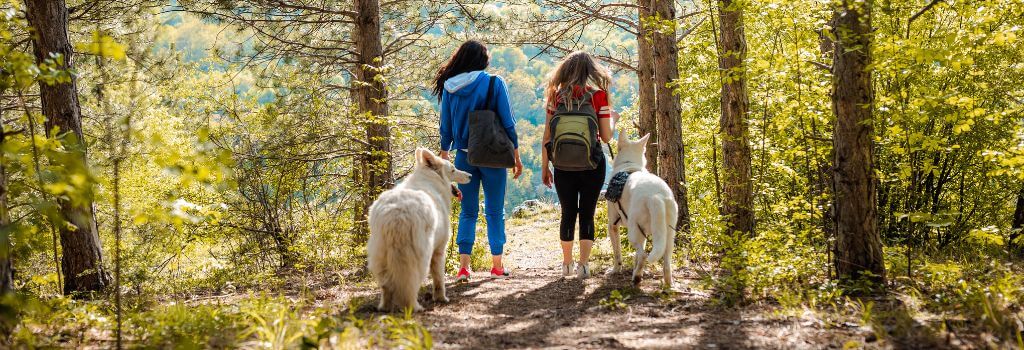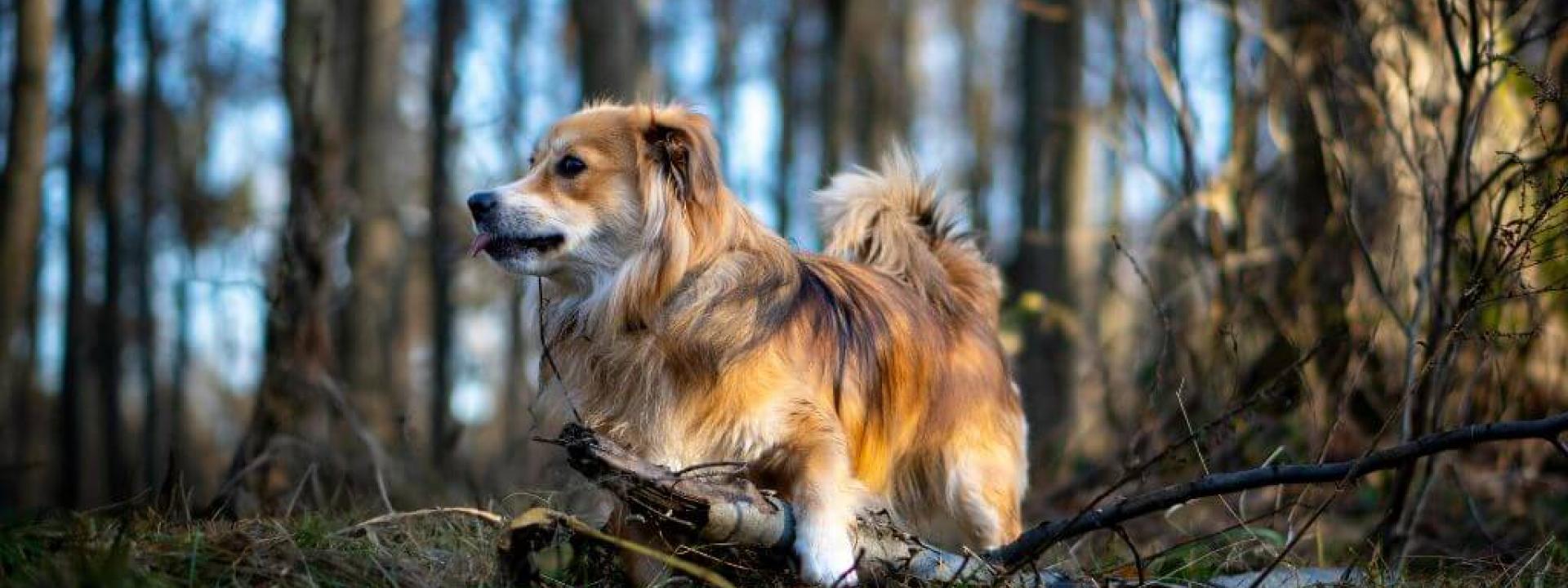Anyone who has come into contact with poison ivy is probably all too familiar with the itchy, red rash that it causes. But what about our dogs? Can they feel the effects of poison ivy, too?
While dogs aren’t as sensitive to poison ivy as humans, they’re not immune to it either, and in some cases, they can even pass it along to you. In this post, we’ll break down everything dog owners need to know about poison ivy: what it looks like, how it affects dogs, what symptoms to watch for, and, most importantly, how to treat it.
Understanding Poison Ivy and How It Affects Dogs
Poison ivy (known scientifically as Toxicodendron radicans) is a common plant found throughout North America that is responsible for causing itchy, irritating rashes on both people and animals. These annoying skin reactions are caused by the plant’s oil, urushiol, which is a known irritant, and is found on the plant’s leaves, stems, and roots – making it pretty unavoidable if you come into contact with a poison ivy plant at all.
What Poison Ivy Looks Like
Poison ivy can grow in a variety of places, and it can often blend in with other non-toxic plants, making it tricky to avoid for some hikers and outdoor enthusiasts. Many have learned to identify poison ivy by its leaves, as each leaf stem has three pointed leaflets. These leaves are commonly green in the spring and summer and may take on a red, orange, or yellow hue in the fall. The saying “Leaves of three, let it be,” has become a helpful way for people to remember the visual hallmarks of poison ivy and that it should be left alone, if you want to avoid a painful and irritating rash. You can find poison ivy growing as vines, shrubs, or even ground cover in woods and forests, fields, along hiking trails or roadsides, or clinging to fences, walls, or tree trunks. It prefers moist, shady areas, but it can also grow in full sun and poor soils, making it an especially hardy – and annoying – plant.

Can Dogs Get Poison Ivy Rashes?
While poison ivy rashes are a relatively common nuisance for many outdoorsy folks across the United States, these dermatological reactions are thankfully less common in dogs. This is due to the protective layer that their coat provides, as well as the fact that dogs are naturally less sensitive to urushiol than humans.
In order for a rash to develop and for dogs to feel the full effects of urushiol, they need to come in contact with their skin. Many breeds of dog thankfully have great coat coverage across most of their body, making a few areas like the belly, groin, muzzle, or inner thighs the only cause for concern. However, hairless dogs, as well as dogs with thin hair or skin conditions, don’t have the same protections and are more likely to be exposed to the oil and develop skin reactions or rashes as a result.
There are a few different ways that dogs can be affected by a poison ivy plant, with rashes and reactions typically stemming from either contact exposure or direct skin absorption.
- Contact Exposure occurs when your dog brushes against the plant, and urushiol oil sticks to their fur and possibly their skin.
- Skin Absorption occurs when contact is made with exposed or thin-skinned areas, and urushiol can seep into the skin, causing a more noticeable reaction.
It’s important to understand that not every time a dog comes into contact with poison ivy will result in a rash or reaction. However, if you are certain that your dog has walked through or touched poison ivy, cleaning them off and assessing their skin is always a good idea to avoid any mishaps.
Other Effects of Poison Ivy on Dogs
In addition to those uncommon but possible rashes, dogs can also be affected by poison ivy in other ways – especially if they ingest any part of the plant. If a dog takes a bite of a poison ivy plant or manages to swallow some, there are some specific health concerns owners should be aware of, including:
- Mouth and Throat Irritation: When a dog eats or puts parts of a poison ivy plant into their mouth, they are introducing urushiol onto their lips, tongue, and throat, which can lead to irritation, drooling, swelling, difficulty swallowing, and pawing at the mouth as a sign of discomfort.
- Gastrointestinal Upset: When ingested, urushiol can irritate a dog’s digestive tract, potentially causing vomiting, diarrhea, loss of appetite, and lethargy.
- Allergic Reaction: In some dogs, ingestion of poison ivy could trigger a more severe allergic reaction, possibly involving facial swelling, hives, and difficulty breathing. As with any severe allergic reaction, this should be treated as a medical emergency, and your dog should be seen by a veterinarian immediately.
- Secondary Effects and Complications: When dogs develop a rash from poison ivy, the itching, scratching, pawing, and licking they do can open the door for a number of secondary complications. With recurring scratching or bothering of the affected area, dogs can damage their skin and create opportunities for infections to develop. They can also spread the urushiol to other parts of their body, increasing the chance of other skin reactions and rashes developing.
Other Plants That May Cause Dog Skin Reactions
Poison ivy isn’t the only plant that can have harmful effects on dogs that owners should be on the lookout for. Poison oak, poison sumac, and stinging nettle are other plants that can have effects similar to those of poison ivy on dogs.
Poison oak is commonly found in the Western and Southeastern United States. Like poison ivy, poison oak also contains urushiol, which can irritate a dog’s skin on contact and cause the same itchy rashes.
Poison sumac, commonly found in wetlands and swampy areas throughout the Northeast and Southeast, also contains urushiol, but is generally considered more potent, making it something pet owners definitely want to steer clear of.
Lastly, stinging nettle, which can be found in moist wooded areas across the United States, does not contain urushiol like the other plants we’ve discussed, but that doesn’t make it any less dangerous. Instead of a toxic oil, stinging nettle has tiny hairs on its leaves and stems that release histamine and formic acid when touched. These substances cause stinging, redness, and swelling.
In addition to these plants that can cause skin rashes on dogs, there are also a number of other plants that are toxic if ingested. If your dog spends a lot of time outside or you have questions about what plants in your area could be harmful to your dog, reach out to your veterinarian. They’ll be able to share information about the harmful or toxic plants present in your area that you’ll want to help your dog steer clear of.
How to Spot It: The Symptoms of Poison Ivy on Dogs
If you have poison ivy in your area and your dog regularly accompanies you on hikes or walks on trails, being able to identify a poison ivy rash can be an invaluable skill that can help you get your dog the relief and treatment they need faster. When it comes to poison ivy on dogs, look out for:
- Red, irritated, or inflamed skin
- Itching or excessive scratching
- Blisters or oozing sores, though these reactions are rare
- Licking or chewing the affected area
What a Poison Ivy Rash on Dogs May Look Like
A poison ivy rash on dogs may be incredibly noticeable or very subtle, depending on the contact your dog had with the poison ivy plant, as well as their own individual reaction. A poison ivy rash on dogs may look like:
- Red or inflamed skin – The area may appear pink to bright red, especially on lighter-skinned dogs.
- Small bumps or raised lesions – These may resemble tiny insect bites or a heat rash.
- Itching and scratching – Dogs may frequently lick, chew, or scratch the affected area, which can worsen irritation.
- Swelling or puffiness – Localized swelling can occur, especially on the face, eyes, or muzzle, if urushiol oil was directly contacted or ingested.
- Blisters or oozing sores – In more sensitive dogs or in cases of heavy exposure, fluid-filled blisters or raw, weeping skin may appear.
- Hair loss or scabbing – Repeated licking or scratching can lead to scabs or patchy hair loss around the rash site.
If the rash seems to spread or worsen over time, or if your dog is showing signs of an allergic reaction, it’s time to get your dog to the vet. A veterinarian will be able to administer proper care and keep your dog more comfortable than an owner would be able to do at home.

Can Dogs Spread Poison Ivy to People?
Many people may not realize this, but, yes, dogs can spread poison ivy to their owners or other animals! Transfer of urushiol from dogs to people is often a bigger concern than rashes appearing on dogs themselves.
How dogs can spread poison ivy: The urushiol oil from the poison ivy plant that is responsible for skin reactions can stick to a dog’s fur and be transferred onto human skin, furniture, clothing, and other animals they may come into contact with. So, even if your dog doesn’t have a rash or appears to be affected by poison ivy, that doesn’t mean you’re in the clear!
How to Treat Poison Ivy On Dogs
If your dog comes into contact with poison ivy, swift and careful action is necessary to prevent any discomfort and the spread of the plant’s oil. To safely handle your dog after a poison ivy incident, follow these steps:
- Wear gloves to avoid spreading the urushiol to any other parts of your dog's body, and make sure you don’t come into contact with it either. The only thing worse than your dog having a poison ivy rash is sporting a matching one yourself because you skipped out on gloves!
- Bathe your dog using lukewarm water and dog-safe shampoo as soon as you are able. Be sure to give a lot of attention to any areas you suspect came into contact with the poison ivy, like their paws, legs, or chest. If you’re in the middle of a hike or a long way from home, dog-safe wipes or plain water can work in a pinch. Just be careful to avoid spreading any oil.
- Once you and your dog are all cleaned up, be sure to give their gear the same treatment. Wash any harnesses, leashes, booties, or other gear that may have come into contact with the poison ivy. Again, we don’t want any lingering oils to be reintroduced onto your or your dog’s skin.
- If a rash develops or your dog is showing signs of pain or discomfort, call the vet. They’ll be able to confirm that you are dealing with a dog poison ivy rash, and they’ll be able to administer treatment and pain relief if needed.
If you have questions and you'd like to reach out to us, you can call us directly at (248) 609-1625, or you can email us at [email protected]. Don't forget to follow us on social media Facebook, Instagram.

